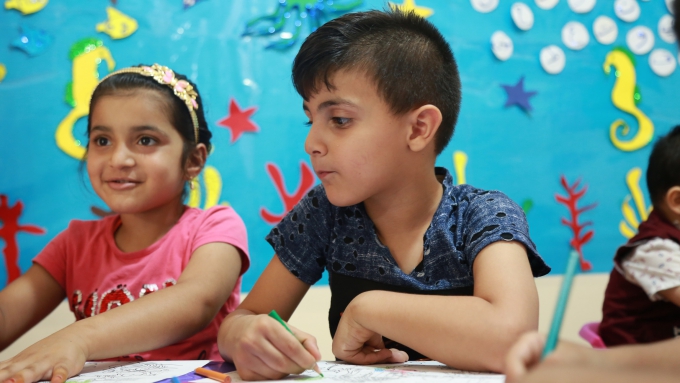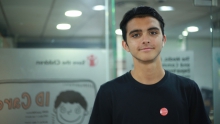From confronting to colouring
By Saro Manoukian*
It was the sound of a whirring pencil that first grasped my attention. All the other children in the class quietly and carefully coloured their pictures, paying close attention to the lines that they had to stay in, but not Ihab. He sat amongst the other children, but acted differently. He scribbled as quickly as he could, all over the page as if there were no lines at all. What he wanted to colour, he coloured, and he coloured with passion.
This was the Ihab I first saw, but this was not the Ihab that first arrived to the classes. Once an introverted child, six-year-old Ihab used to sit alone. According to his mother, he would “sit by himself for hours and not say a word”, and whilst eating, he would “throw his food off the table”. His mother worried that his patterns of behaviour were a sign of autism.
This behaviour, likely, came as a result of the stress experienced both in Syria and even at home. In his mother’s words, they “had just arrived from Syria and had a second baby arriving. It all affected Ihab mentally”. These factors are inevitably tough on a young mind. Such trauma can manifest into violence, and his teacher at Save the Children’s Early Childhood Care and Development classes noticed a level of aggression and hostility within him, aimed at the other students. Through patience and care, his teacher was able to improve his situation, and turn things around. He was given space and encouragement, both of which contributed to his academic improvement.
His change was not immediate though, but like all growth, took time. Most of the students in the class looked happy, including Ihab himself. But this was not always the case. His teacher told me that most children in the class seem to adapt, but not all children. Ihab used to be one of those students. “He would sit by himself and not take part in any game”, his teacher, Fatima, says, “He wouldn’t let other children talk to him”.
He was not a stranger to his new environment for very long. Over time, he integrated with the class, dispelling his outsider status. That was the Ihab I saw. Isolation was not a word that I would have associated with him, but his behaviour was noticeably different from the others. His energy was apparent, but not in any way that would be hostile to the children surrounding him. In fact, he seemed to have discovered a new way to channel his emotions. “I like to colour the goat most of all. [On the colouring page] I have a donkey, a horse, a duck and a cow, [but my] favourite [is the] goat”.
These are Ihab’s own words, and they are key to understanding his mind. The energetic colouring was what made him stand out against the crowd. The colouring was a pure way, to express the emotions kept bottled up inside of him, a way of converting his aggressive characteristics to ones that are simply energetic.
Aggression is never encouraged, but Ihab’s ability to re-channel his emotions in a positive way is greatly impressive, seeing as he is no longer harmful. What was once aggression has now transformed into enthusiasm. I hope that, over time, he manages to release what he must release, and then allow himself room to grow, and I have faith that he will, with the caring assistance of both his teachers and the Save the Children staff. Nobody can expect these children to dismiss their emotions, all we can do is help them control them, and help them move on.
*About Saro Manoukian: Saro Manoukian is a student from London, volunteering to work with Save the Children Lebanon’s Media, Advocacy and Communications Department (MAC). As part of a two week volunteering programme, he visited Save the Children’s Early Childhood Care and Development classes, and wrote an article based on his observations.
 Lebanon
Lebanon 
